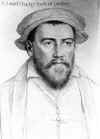Edward STANLEY
(3rd E. Derby)
|
Born: 10 May 1508/9, Lathom House, Omskirk, Lancanshire,
England
Acceded: 1521
Died: 24 Oct 1572,
Lathom House, Omskirk, Lancanshire, England
Buried: 4 Dec 1572,
Ormskirk, Lancanshire, England
Notes: Knight of
the Garter.
Father:
Thomas STANLEY (2° E.
Derby)
Mother: Anne
HASTINGS (C. Derby)
|
.gif) |
Married 1:
Catherine
HOWARD (C. Derby)
1529
Married 2:
Dorothy
HOWARD (C. Derby) 21 Feb 1530
Children:
1.
Henry STANLEY (4° E. Derby)
2.
Maria STANLEY (B. Stafford)
3. Thomas
STANLEY (Sir)
4.
Jane STANLEY (B.
Sutton of Dudley)
5. Anne
STANLEY (B. Stourton of Stourton)
6. Catherine STANLEY
7.
Elizabeth STANLEY (B.
Morley)
8. Margaret
STANLEY
9. Edward STANLEY (Sir) (d. 1609)
Married 3: Margaret
BARLOW (C. Derby) (d. 19 Jan
1558 - bur.
24 Feb 1558, Ormskirk) (dau. of Ellis
Barlow and Anne
Redish) 1547,
Lathom, Lancashire, England
Married 4: Mary
COTTON (C. Derby / C. Kent) (d. 16 Nov 1580) (dau. of
Sir
George Cotton and
Mary Onley) (m.2 Henry Grey,
6° E. Kent) BEF 1 Jan 1561/2

Edward was about thirteen years old when he succeeded to his father's
title and
estates, and the King took responsibility for his upbringing until he came of age,
his affairs were managed by commissioners, of whom
Cardinal Wolsey was one, the
governor and other civil authorities in Man being continued in office until he
attained his majority.
In 1528, he attended the
Cardinal on an embassy to France; and, in 1530, he was one of the
peers who subscribed the declaration to Pope Clement VII. That,
if he refused to confirm the divorce of
Queen Catalina, his supremacy
in England would be endangered.
In 1530, Thomas Howard, Duke
of Norfolk found himself in trouble over what he must have
considered a mere formality, the requirement for the
King's assent to all marriages
within the peerage. Norfolk
arranged for his eldest daughter, Catherine, to wed Edward Stanley,
whose family had long held considerable influence in the north of the realm.
Henry choose to view the
arrangement as an abduction of the twenty year old Derby, who was still
legally a minor. On 21 Feb 1530,
Norfolk was forced to sue for pardon and post a bond with the
King, but was still allowed to
carry the marriage to conclusion. Catherine Howard was at least twenty
two years old when a few weeks later, on 16 Mar 1530, died suddenly of the
plague. Anxious not to loose this alliance the
Duke arranged for his half-sister,
Dorothy to become Derby's second wife.
Norfolk considered the Derby
marriage to be so important that he 'had no had a sister to offer he would
have proposed his oher daughter...' who has been promised to the
King bastard son, the
Duke of Richmond.
In 1532, he issued a commission to inquire into the exactions which the
people of Man alleged were practised by the clergy under the guise of mortuaries
or corpse-presents. In the same year he was present with
Henry VIII at his interview with
Francois I at Boulogne, and, in 1533, he was made a Knight of the Bath.
He took a prominent part in suppressing the
northern rebellion in 1536 and
1537. In 1542, he accompanied the
Duke of Norfolk, on his raid into Scotland.
On the accession of Edward VI
in 1547, he received the Garter; and, in 1550, he was one of the peers who were
parties to the articles of peace with the Scottish and French. In Jun 1551, it
was reported that he had been commanded to renounce his title to the Isle of Man
and that he had refused, being prepared to resist by force. It is not known what
truth there is in this, but, if any action was intended to have been taken
against him, it was probably on account of his strong opposition to all
religious changes.
For the same reason, he would have been in high favour on the accession
of Queen Mary. He was then
appointed
Lord High Steward of England and a member of the Privy Council. He was
a commissioner for the trial of Lady Jane
Grey and others, and, during Mary's
reign, he frequently took part in the proceedings against heretics.
He contrived to secure the favourable opinion of
Queen Elizabeth, being one of those
summoned to meet her on her entry into London. She retained him as a privy
councillor and, in 1559, she appointed him chamberlain of Chester.
In 1561, he appointed five commissioners to examine into and establish
regulations for preventing the "great Waste that hathe been made in the
Castle, and in the Peele, in bread, fuell, candles, and other things", and
to fix the fees of certain officers and the amount of fines and amercements due
to the Lord of the Isle for infringement of the laws.
The Earl died 24 Oct 1572, at Lathom House, and was buried 4 Dec 1572. He
was suceeded by his eldest son, Henry,
as fourth Earl of Derby.
"With his death
the glory of hospitality seemed to fall asleep"
William Camden.
.gif)




